The final stage of the Dun Laoghaire to Dingle Race, the 15 miles from Skellig Michael to the finish line on the north shore of Dingle Bay at the ampitheatre-like entrance to Dingle Harbour, may seem like an easy jaunt after what the fleet has been experiencing on the more exposed parts of the course writes W M Nixon.
But for contenders in the 2019 race, it provided a final extra test of stamina and determination, for many of them were sailing it in the dark. And with the forecast rain which was supposed to envelop Kerry tending to go to Clare and Galway, there was a distinct backing of the northerly wind and a chance to race at extra speed through the night to the finish, and pick up a place or two on the way if only the spark was still there to be harnessed.
Three top boats did this with conspicuous style. After Mick Cotter’s 94ft Windfall had taken line honours and established a new course record, the race was on to see which of the more normally-sized boats might get second on the water, and for almost the entire race the betting was in favour of Andrew Hall’s last-minute entry from Wales, the very slippy J/125 Jackknife.
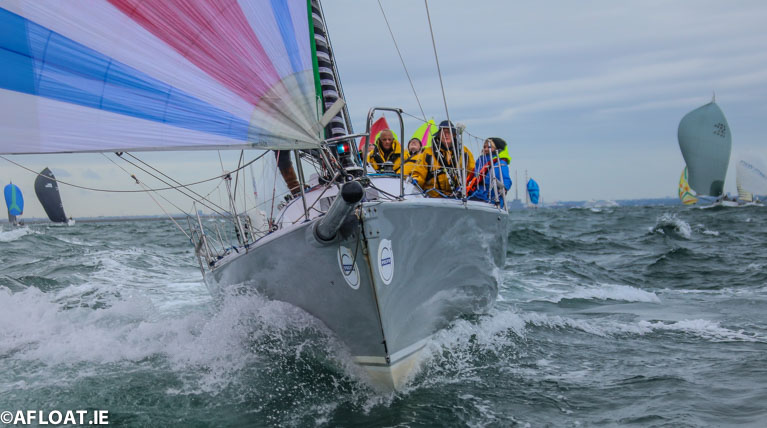 The J/125 Jackknife is a flying machine, but she’s also a distinctly skinny boat of minimal onboard comforts. Photo: Afloat.ie/David O’Brien
The J/125 Jackknife is a flying machine, but she’s also a distinctly skinny boat of minimal onboard comforts. Photo: Afloat.ie/David O’Brien
But the J/125 is a very minimalist boat in terms of creature comforts, and a second night at sea in what had been a tough and very cold north wind-dominated race would have been making harsh demands on her crew.
Yet aboard Conor Doyle’s Xp50 Freya, a boat of substance and comfort, they could take it in their stride, and with talents aboard like Kenneth Rumball, the attractive big Freya seemed to be going better with every mile sailed.
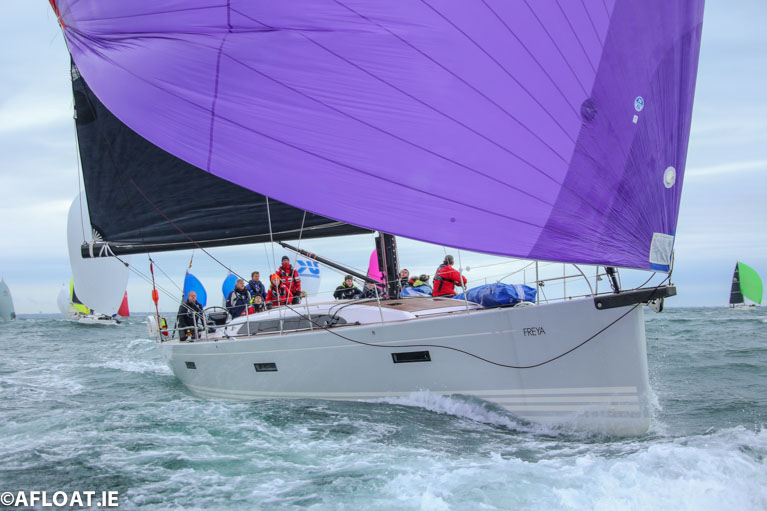 Speed and comfort – Conor Doyle’s Xp 50 Freya had a storming night-time finish in the Dingle Race to take second in line honours. Photo: Afloat.ie/David O’Brien
Speed and comfort – Conor Doyle’s Xp 50 Freya had a storming night-time finish in the Dingle Race to take second in line honours. Photo: Afloat.ie/David O’Brien
All the way up the beat from Mizen head to the Skellig, they were closing what had at one time been a 12-mile gap behind Jackknife. They were still astern making the final turn, and for the eased sheets passage to the finish, it might have been assumed that Jackknife would be back in charge.
Not a bit of it. Freya remorselessly wore down her lead as they raced through the night, and when they crossed the line at 02:09 in the small hours of Friday morning, Freya was four minutes ahead.
The overall winner Rockabill had meanwhile been sailing an exemplary race. In the long run down the east coast, they made good straight line progress under spinnaker while other boats went hither and yon tacking to lee. The guys on Rockabill know their boat, they knew that once the breeze had freshened again after its hiccup at the start this was the way for the best basic speed, and consequently they kept themselves in the frame while conserving energy.
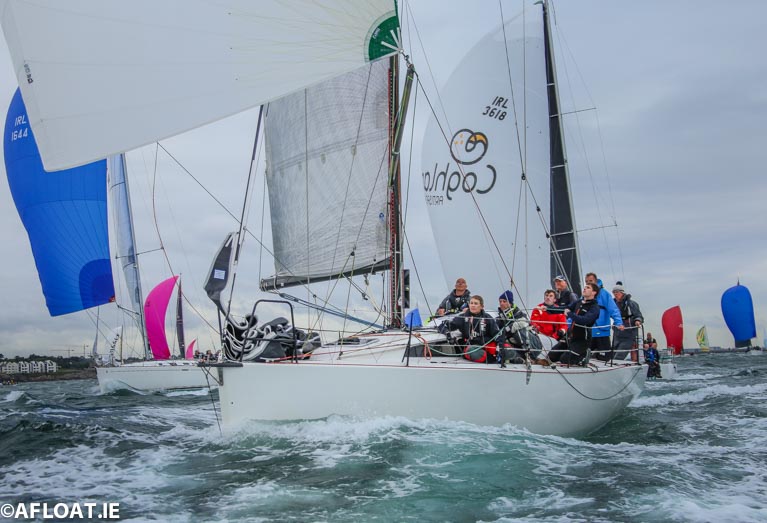 Energy conservation……Rockabill under standard masthead spinnaker getting maximum speed for minimum hassle. Photo: Afloat.ie/David O’Brien
Energy conservation……Rockabill under standard masthead spinnaker getting maximum speed for minimum hassle. Photo: Afloat.ie/David O’Brien
All along the south coast Rockabill was always there or thereabouts, and sometimes in first place on IRC, but her crew knew that if the forecast brisk breezes from ahead were experienced off the southwestern seaboard, they’d be in their element with energy to burn.
And they’d a private race going with the higher-rated J/122 Aurelia. Aurelia may have led round the Skellig, but Rockabill was hounding her, and in the romp up the bay, she rolled over the J boat and got in four minutes ahead of her to correct into an overall lead which was soon unbeatable by any boat still out racing.
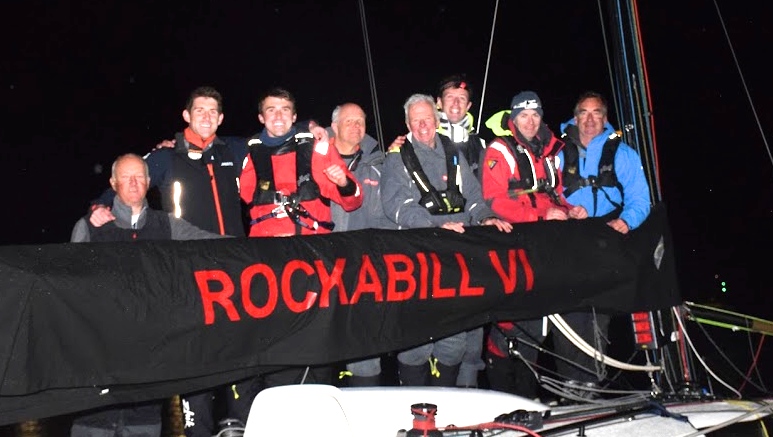 Rockabill’s winning crew brighten the Dingle darkness, with Mark Pettit on left (almost smiling), and owner/skipper Paul O’Higgins fourth from right. Photo: Dominick Walsh
Rockabill’s winning crew brighten the Dingle darkness, with Mark Pettit on left (almost smiling), and owner/skipper Paul O’Higgins fourth from right. Photo: Dominick Walsh
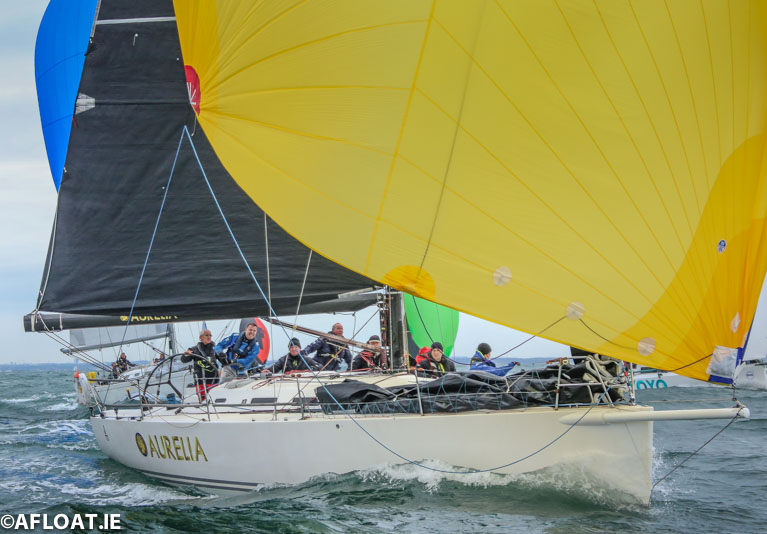 Aurelia at the start – she was to place second overall on IRC. Photo: Afloat.ie/David O’Brien
Aurelia at the start – she was to place second overall on IRC. Photo: Afloat.ie/David O’Brien
Next in after Aurelia were the Martin brothers in the First 44.7 Lively Lady – they’ve been having the race of their lives, and while Lively Lady may have moved down to tenth on corrected time, it has been a remarkable sail they’ll remember for a long time.
Close behind Lively Lady as the new day hinted was one of the most interesting duels of all. Former Olympian Mark Mansfield was on the strength of John O’Gorman’s Sunfast 3600 Hot Cookie (NYC), and the big Corkman found reserves of speed and stamina in the Cookie crew that they didn’t know they possessed.
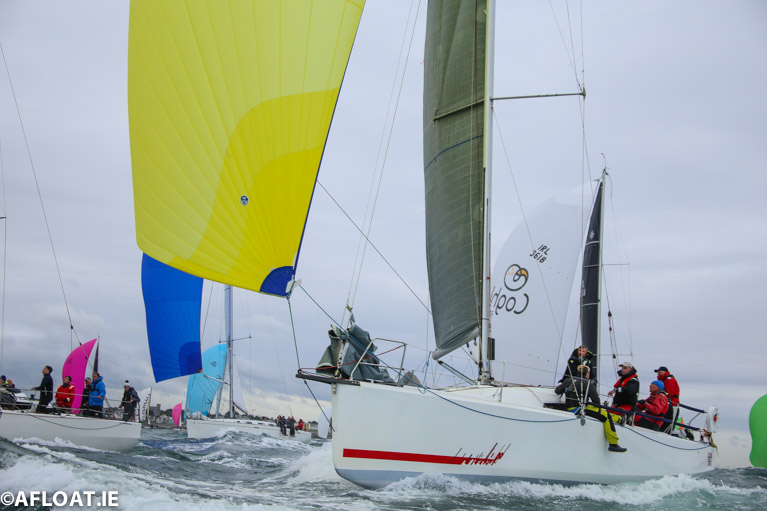 The Sunfast 3600 Hot Cookie (John O’Gorman) with the unmistakable presence of Mark Mansfield at the stern. Photo: Afloat.ie/David O’Brien
The Sunfast 3600 Hot Cookie (John O’Gorman) with the unmistakable presence of Mark Mansfield at the stern. Photo: Afloat.ie/David O’Brien
Thus in the beat up to the Skellig, they were snapping at the heels of Conor Fogerty’s very new Figaro 3 Raw – an ironic state of affairs, as Fogerty’s previous all-conquering boat Bam had been a Hot Cookie sister-ship.
Once the turn had been made and sheets freed, you’d have expected the foiling Raw to be gone. No way. Big Mark and his shipmates sailed like men possessed, and they beat Raw to the finish by precisely one minute.
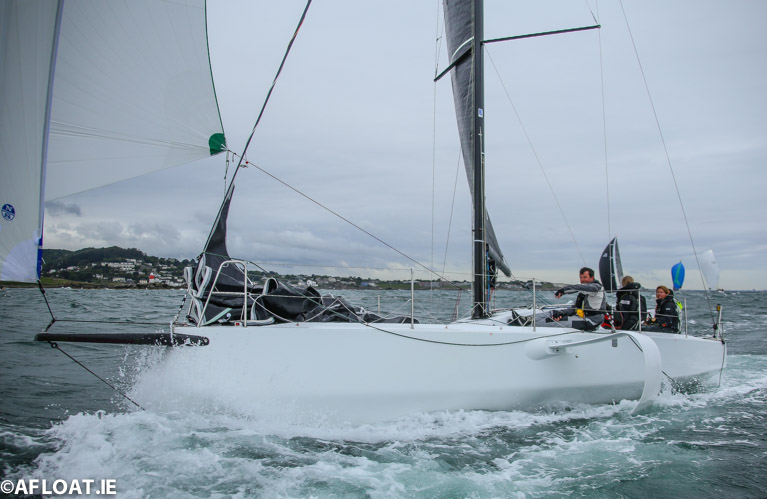 Conor Fogerty’s new Figaro 3 Raw was 8th to finish, and placed 18th on corrected time. Photo Afloat.ie/David O’Brien
Conor Fogerty’s new Figaro 3 Raw was 8th to finish, and placed 18th on corrected time. Photo Afloat.ie/David O’Brien
Throughout this diverse fleet, there’ll have been local duels like this going on at every part of the course. But it was a grand-standing finale that three of these duels at the very top level were fought with such tenacity right into the final furlong and through the line.
Managing the energy levels is a very significant part of offshore racing. It’s all very well having all hands on deck to squeeze every ounce of performance out of the boat when the crowds are still there to watch at the start, but in cold wet weather with headwinds towards the end, the need for a fresh watch to be available is paramount.
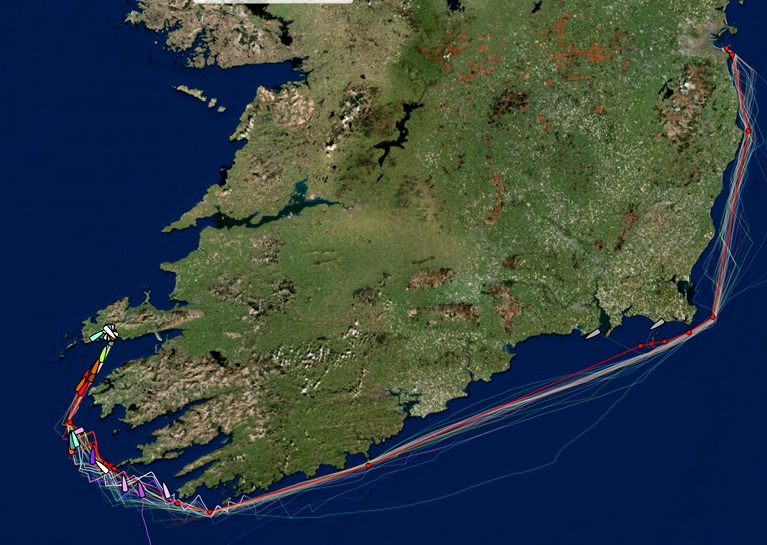 The tracks on the 270 mile course tell it all. Off the East Coast, the Mini 6.50s tacked to lee right out into the middle of the Channel, logging more than 300 miles, while on the south coast Windfall went well offshore in search of reported stronger winds and logged 299 miles. But two boats – overall winner Rockabill VI and early leader Outrajeous –managed to get to Dingle on just 277 miles
The tracks on the 270 mile course tell it all. Off the East Coast, the Mini 6.50s tacked to lee right out into the middle of the Channel, logging more than 300 miles, while on the south coast Windfall went well offshore in search of reported stronger winds and logged 299 miles. But two boats – overall winner Rockabill VI and early leader Outrajeous –managed to get to Dingle on just 277 miles
Thus Rockabill’s race has been a textbook performance in energy conservation. And it shows most vividly in the actual distance she sailed. It was a minimal 277 miles. Only one other boat – the J/109 Outrajeous skippered by Johnny Murphy to an eventual 6th overall after leading the J/109s all the way to the Fastnet – managed to get to Dingle on only 277 miles.
However, we shouldn’t let total economy of distance sailed dominate our thinking too much, there are many other factors involved. The reality is that the J/109 leader at the finish, the Shanahan family’s Ruth skipppered by 19-year-old Tom Shanahan who overtook Outrajeous with such a flourish at the Fastnet, did the course in 279 miles to place fourth overall and first in the Corninthian Division, a great achievement for such a young skipper.
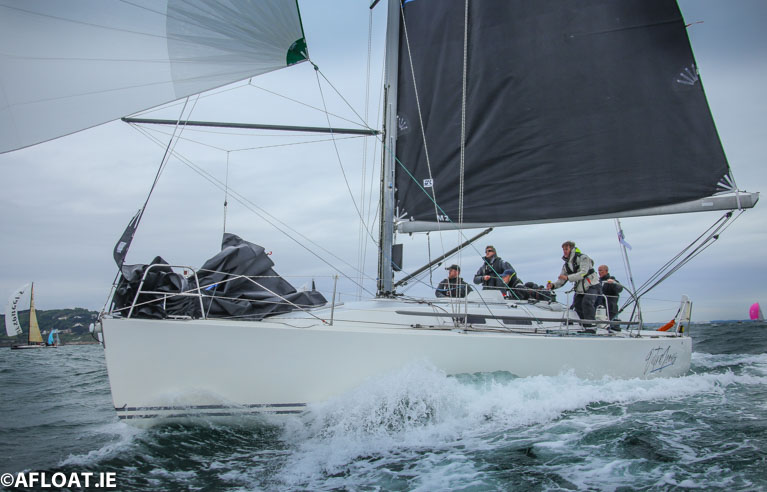 The J/109 Outrajeous was one of only two boats which managed to get to Dingle logging only 277 miles. Photo: Afloat.ie/David O’Brien
The J/109 Outrajeous was one of only two boats which managed to get to Dingle logging only 277 miles. Photo: Afloat.ie/David O’Brien
Some really piled it on. For instance Windfall, in trying to find fresher northerlies offshore as she led the reach along the south coast, curved her course so much she was looking at 299 miles by the finish.
And the gallant little Mini 6.50 Port of Galway, which Dan Mill and Yannick Lemonnier were tacking to lee with such enthusiasm during all the run down the east coast that at times they were sometimes nearly in the middle of the Channel, well, when they finished at lunchtime yesterday 7 miles ahead of Louis Mulloy in Blackshell Farm, they were showing 305 miles logged.
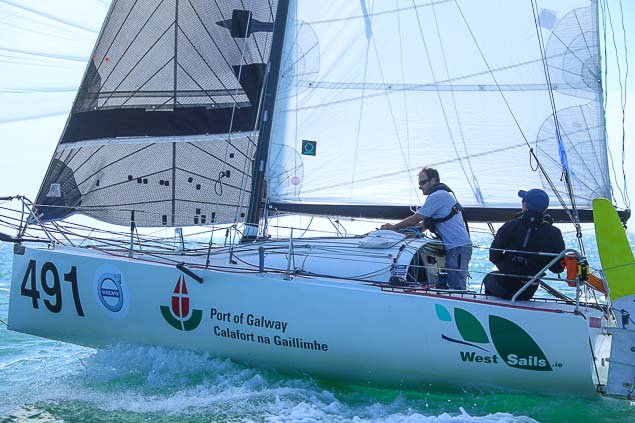 The Mini 6.50 Port of Galway (seen here at the start of the 2018 Round Ireland Race) managed to log 305 miles racing to Dingle. Photo: Afloat.ie/David O’Brien
The Mini 6.50 Port of Galway (seen here at the start of the 2018 Round Ireland Race) managed to log 305 miles racing to Dingle. Photo: Afloat.ie/David O’Brien
Yet vigorous tacking to lee is the best way to get optimum VMG out of a Mini 6.50. But a Steady Eddy JPK 1080 like Rockabill VI under a traditional masthead spinnaker can hold the straight line, and still be giving of her best. It all depends on wind strength, of course, but it meant that when the energy was really needed in the final 50 miles of the race, Rockabill still had it by the bucket-load.
They were fresh as daisies at the finish, for success brings its own adrenalin, but there were some very tired and cold sailors finally getting into avail of Dingle’s warm hospitality. As for tonight’s mega prizegiving at the Dingle Skellig Hotel, there are so many divisions and categories and so many special awards that it seems likely there’ll be more or less something for everyone in the audience.
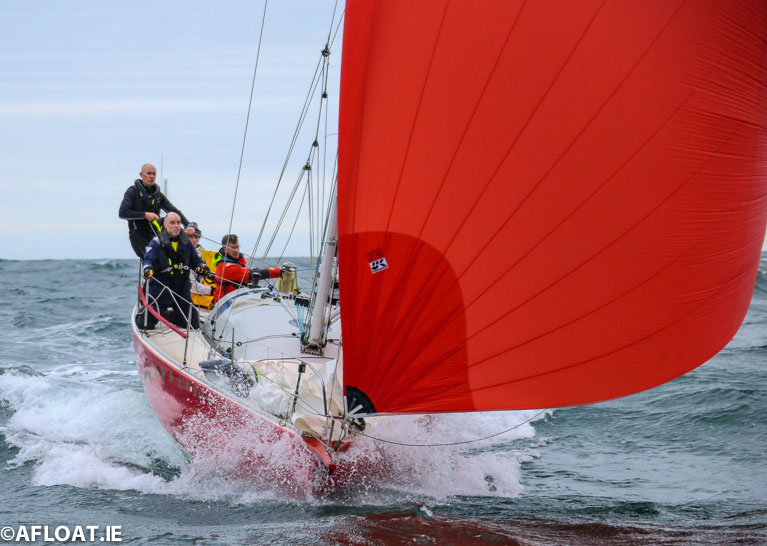 Rupert Barry’s JOD Red Alert from Greystones was winner of IRC 2. Photo: Afloat.ie/David O’Brien
Rupert Barry’s JOD Red Alert from Greystones was winner of IRC 2. Photo: Afloat.ie/David O’Brien
Thus although the fully-crewed hotshot boats and the big record-breaker inevitably have been receiving all the attention, we mustn’t forget that there were two IRC Classes, and Rupert Barry’s JOD 35 Red Alert from Greystones won IRC 2, while placing 14th overall, and there was also a keenly-contested two-handed division which was won Colm Buckley and Simon Knowles from Howth with the J/109 Indian, which they sailed to such good effect that they also took 12th overall in the 41-strong open division.
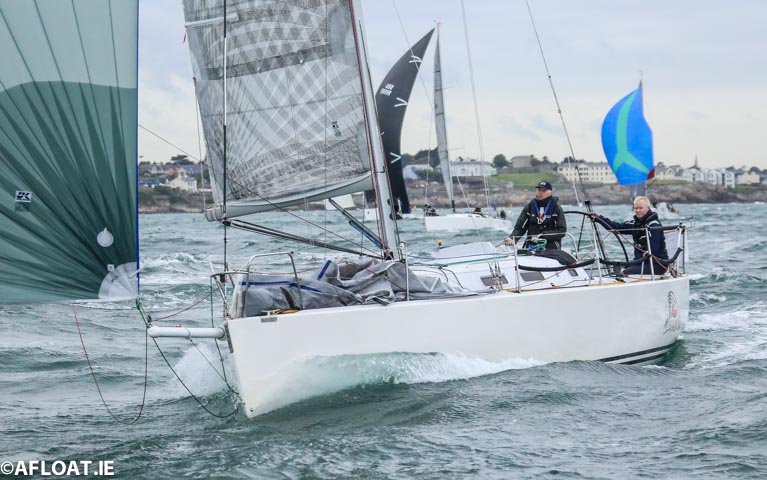 Simon Knowles and Colm Buckley with the J/109 Indian (HYC) have won the Two-Handed Division, and placed 14th overall. Photo: Afloat.ie/David O’Brien
Simon Knowles and Colm Buckley with the J/109 Indian (HYC) have won the Two-Handed Division, and placed 14th overall. Photo: Afloat.ie/David O’Brien
In among the two-handers was the only wooden classic in the race, Paul Moxon’s 1939-built 50ft Amokura. Unfortunately after looking very stylish at the start, she suffered upper spreader damage further down the line, and at the time of writing is carefully plodding towards the finish under reefed main and storm jib, but the hope is she’ll make it to Dingle in time for the party.
 The classic 50ft yawl Amokura (Paul Moxon) was doing very well despite being Two-Handed, but she has been slowed by rigging damage. Photo: Afloat.ie/David O’Brien
The classic 50ft yawl Amokura (Paul Moxon) was doing very well despite being Two-Handed, but she has been slowed by rigging damage. Photo: Afloat.ie/David O’Brien
Either way, there’ll still be more Dun Laoghaire to Dingle Race veterans around Dingle tonight than at any time in the race’s 26-year history. Such a gathering will make for a story in itself. Adam Winkelmann and Con Murphy and their many voluntary helpers have pulled off a real success, and deserve every congratulation.
 Big boat in the big country – Windfall finishes the Dun Laoghaire to Dingle race in a new record time. Photo: Richard & Rachel Langdon/Ocean Images
Big boat in the big country – Windfall finishes the Dun Laoghaire to Dingle race in a new record time. Photo: Richard & Rachel Langdon/Ocean Images
Read all the D2D Race News in one handy link here and download overall results pdf below
































































